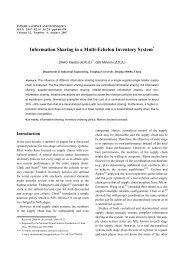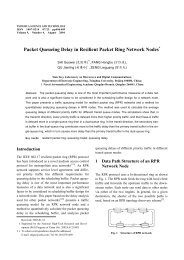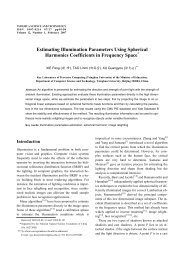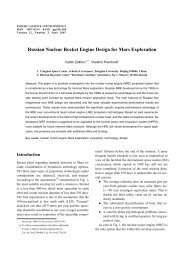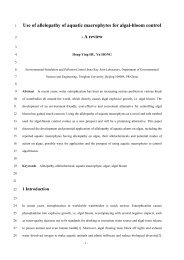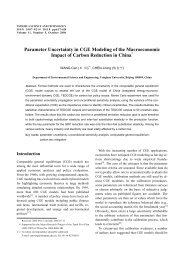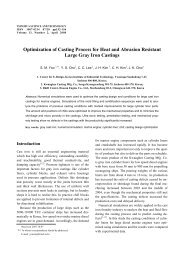Coordination by Option Contracts in a Retailer-Led Supply Chain with
Coordination by Option Contracts in a Retailer-Led Supply Chain with
Coordination by Option Contracts in a Retailer-Led Supply Chain with
Create successful ePaper yourself
Turn your PDF publications into a flip-book with our unique Google optimized e-Paper software.
574<br />
quantities ( q1, q 2)<br />
that maximize his own expected<br />
profit, subject to the retailer’s order<strong>in</strong>g behavior. His<br />
decision on the second-stage production is relatively<br />
straightforward, i.e.,<br />
* * *<br />
q2 = max{ d − q1,0}<br />
.<br />
The difficulty lies <strong>in</strong> his decision on q 1 . Obviously<br />
he should at least produce d 1 , but should he produce<br />
more? The answer depends on his estimate on the likelihood<br />
of the retailer’s second order. For such a decision<br />
his problem is<br />
ε ( d1)<br />
max Π ( q ) = wd − cq + v( q − d )d G(<br />
ε)<br />
+<br />
q1d1 S 1 1 1 1 1<br />
0<br />
1 1<br />
ε ( q1<br />
)<br />
∫ ε ( d1)<br />
∞<br />
wd 2 2 vq1 d G<br />
∫<br />
ε ( q1<br />
)<br />
∫<br />
[ + ( − )]d ( ε ) +<br />
[ wd −c( d−q)]d G(<br />
ε ).<br />
2 2 2 1<br />
The solution to this problem is given <strong>by</strong> Lemma 3.<br />
Lemma 3 Given the retailer’s order<strong>in</strong>g behavior,<br />
the supplier will maximize his expected profit <strong>by</strong><br />
sett<strong>in</strong>g<br />
* *<br />
q1 d1 q′ 1<br />
* * *<br />
= max{ , } and q2 = max{ d − q1,0},<br />
where 1 q′ is implied <strong>by</strong> c2 − c1<br />
G( ε ( q′<br />
1))<br />
= .<br />
c2−v Because this problem has a newsvendor structure,<br />
the first order condition works. The proof is straightforward<br />
so the details are omitted. These problems<br />
have reviewed the benchmark and decentralized uncoord<strong>in</strong>ated<br />
system performance. Although the precise<br />
relationships between * *<br />
d 1 , q 1,<br />
and c<br />
q 1 depend<strong>in</strong>g on<br />
factors like the ratio of the two production costs, the<br />
ratio of the two wholesale prices, and the estimate of<br />
the market signal cannot be determ<strong>in</strong>ed, the channel is<br />
certa<strong>in</strong>ly not coord<strong>in</strong>ated. This is implied <strong>by</strong> Lemma 2<br />
which states that for a given market signal the retailer’s<br />
total order quantity is less than the optimal total <strong>in</strong>ventory<br />
required <strong>in</strong> a centralized system. The next section<br />
focuses on how an option mechanism coord<strong>in</strong>ates<br />
the supply cha<strong>in</strong> and realizes profit allocation.<br />
2 Channel <strong>Coord<strong>in</strong>ation</strong><br />
To coord<strong>in</strong>ate the channel, the retailer must choose the<br />
proper contract parameters so that the supplier’s production<br />
quantities <strong>in</strong> each period are equal to the opti-<br />
* c<br />
mal solutions <strong>in</strong> the centralized system, i.e., q = q<br />
and<br />
1 1<br />
* c<br />
q = q . To do so the retailer must give <strong>in</strong>centives<br />
Ts<strong>in</strong>ghua Science and Technology, August 2008, 13(4): 570-580<br />
to the supplier to overproduce <strong>in</strong> each period. Recall<br />
that q1d1 and q2 max{ d − q1,0}<br />
. Thus d 1 and<br />
max{ d − q1,0}<br />
are the m<strong>in</strong>imum production number<br />
for the supplier’s production <strong>in</strong> each period. The coord<strong>in</strong>at<strong>in</strong>g<br />
contract is def<strong>in</strong>ed as follows: The option contract<br />
has three parameters of two option prices o 1 and<br />
o 2 and one exercise price e . The option prices are<br />
the unit compensation for the supplier’s production<br />
quantities beyond the m<strong>in</strong>imums <strong>in</strong> each period. When<br />
the realized demand exceeds the retailer’s total order,<br />
he will purchase the supplier’s excess <strong>in</strong>ventory, if any,<br />
to meet the market demand at a unit price e .<br />
The sequence of events is summarized as follows:<br />
(1) At the beg<strong>in</strong>n<strong>in</strong>g of period 1, the retailer sets a<br />
firm order d 1 . The retailer also announces an option<br />
contract <strong>with</strong> option prices o 1 and o 2 and exercise<br />
price e. The supplier, <strong>in</strong> turn, decides to produce<br />
q1 d1<br />
of goods <strong>in</strong> the cheap mode which will produce<br />
an <strong>in</strong>come of o1( q1− d1)<br />
.<br />
(2) At the beg<strong>in</strong>n<strong>in</strong>g of period 2, after the market<br />
signal is observed, the retailer orders d 2 . The supplier<br />
selects a second-period production, q2 max{ d− q1,0}<br />
,<br />
that <strong>in</strong>volves the expensive mode and produces an <strong>in</strong>come<br />
of o2( q2 −max{ d − q1,0})<br />
.<br />
(3) At the beg<strong>in</strong>n<strong>in</strong>g of the sell<strong>in</strong>g season, after the<br />
demand is realized, the retailer purchases additionally<br />
m= m<strong>in</strong>{max{ D−d,0}, q− d}<br />
number of goods at<br />
unit price e . The supplier delivers all that the retailer<br />
wants. The problem assumes that the supplier is obligated<br />
to fill the retailer’s entire order and can neither<br />
sell directly to the f<strong>in</strong>al customer (i.e., the retailer’s<br />
customer) nor supply <strong>in</strong>ventory <strong>in</strong> excess of the retailer’s<br />
total order quantity.<br />
With the option contract, the supplier’s problem<br />
becomes<br />
max Π ( q ) = −( c − o ) q + ( w − o ) d +<br />
q1d1 S 1 1 1 1 1 1 1<br />
∫<br />
0<br />
∞<br />
Π ( ε, q , q )d G(<br />
ε),<br />
S 1 2<br />
where ΠS( ε, q1, q2) = max πS( ε,<br />
q1, q2)<br />
and<br />
q2max{ d−q1,0} π ( ε , q , q ) = − c q + o ( q −max{ d − q ,0}) +<br />
S 1 2 2 2 2 2 1<br />
d<br />
wd + vq ( + q − d)d F( x|<br />
ε ) +<br />
∫<br />
2 2<br />
0<br />
1 2<br />
q1+ q2<br />
d<br />
∫<br />
[( ex− d) + vq ( − x)]d Fx ( | ε ) +



